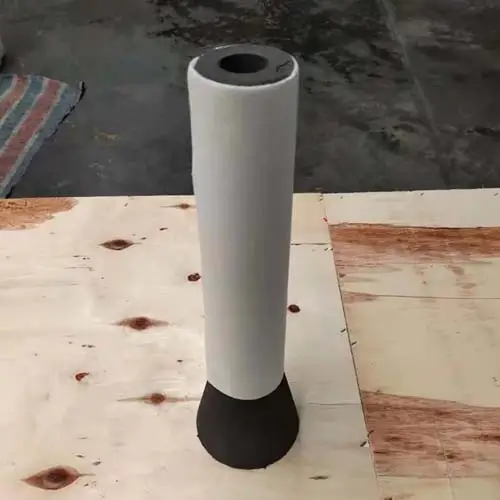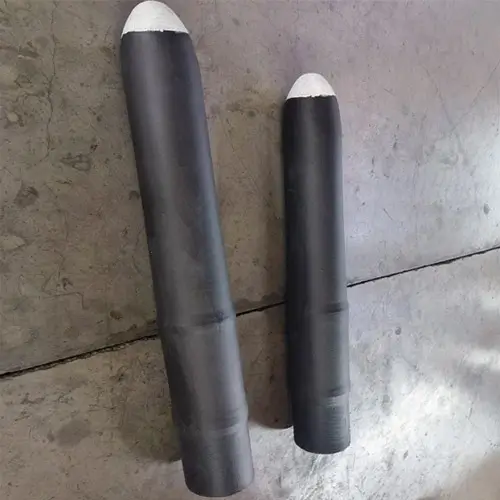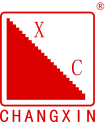Since the introduction of continuous casting technology in the 1950s, continuous casting functional refractories were also born. Accompanied by the progress of metallurgical technology, the expansion of steel, casting billet quality and service life extension, continuous casting functional refractories have also been developed significantly to improve the flow control, rectification and protection of the casting function, to prevent oxidation, nitrogen enrichment and inclusions. Continuous casting with functional refractories refers to the Monoblock Stopper, (ladle) long nozzle and submerged entry nozzle, known as the continuous casting of the three big pieces, some people also put the ladle slide gate, tundish slide gate, tundish upper nozzle on the mouth of the water is included, are carbon-containing refractory materials, commonly known as the combination of carbon refractory materials. In fact, the tundish ladle slide plate flow control structure has become increasingly rare, there is a tendency to be replaced by the plug bar. In this paper, we mainly discuss the raw material technology for the production and manufacture of functional refractories for continuous casting.
1.Performance requirements for materials
Continuous casting requires its functional refractories have good thermal shock resistance, resistance to synthetic slag erosion, resistance to steel erosion and appropriate high temperature strength. These characteristics of the requirements and due to the use of the three parts of the parts and steel, smelting conditions are different and there are differences.
Submerged Entry Nozzle
(1) Excellent thermal shock resistance. The nozzle is generally preheated to 1100°C before use, but the temperature of molten steel during continuous casting is as high as 1500°C. The nozzle needs to withstand a thermal shock temperature difference of 400°C within 1 second.
(2) It has good resistance to mold slag erosion. The zirconium carbon material used in the slag line has enhanced slag corrosion resistance due to the introduction of ZrO2. However, the zirconium carbon material has a risk of thermal shock explosion due to its low carbon content and the phase change of ZrO2. Therefore, it is required not to cool down too much after preheating. quick. At the same time, if the zirconium carbon material is in direct contact with the molten steel in the inner hole, its graphite content and bonding strength are low, and it will be quickly melted under the erosion of the high-speed steel flow. Therefore, it must be used in conjunction with the main aluminum carbon material or lining material.
(3) It has good resistance to erosion by molten steel, especially the inner hole, which must resist both erosion by molten steel and chemical erosion. The body part immersed in the crystallizer is rarely corroded, which is the main reason for choosing the aluminum carbon submerged entry nozzle.
(4) Good anti-clogging properties. Sedimentation and clogging of the nozzle is a more serious and common problem than erosion of the inner hole, especially for the pouring of aluminum-killed steel. At present, changing the material and flow pattern is an ideal technical route to solve the clogging problem.
(5) High-temperature strength requirements are particularly important, and are higher than those for long nozzles and submerged entry nozzle. The molten steel cannot fall to the bottom when it hits, and it cannot break when the molten steel swings. Theoretically, the high temperature flexural strength at 1200℃ is required to reach 2.5MPa. In actual production, the normal temperature flexural strength after burning is controlled to not be less than 6MPa.

Monoblock Stopper
(1) Good thermal shock resistance, but not as demanding as the submerged entry nozzle and long nozzle, because the stopper rod is only immersed in the molten steel from the outside instead of the inner hole, and the heat transfer is from the outside to the inside; in addition, the stopper rod is often packaged with the tundish At the same time, preheating also reduces its thermal shock resistance requirements.
(2) Resistance to slag erosion is not originally a problem for plug rods. However, with the popularization and application of high-alkaline covering agents and the continuous increase in the number of continuous casting furnaces, especially the continuous casting of square billets and round billets requires continuous casting of 20 hours. As mentioned above, the erosion of the plug rod slag line by the tundish covering agent and slag is highlighted. General aluminum carbon materials are difficult to resist. Many manufacturers have compounded zirconium carbon materials, such as zirconium carbon materials for immersed nozzle slag lines and ordinary aluminum. Each carbon material is 50%(w) compounded.
(3) The higher the corrosion resistance of molten steel, the better, especially the rod head material. This is because the rod head area is subject to continuous erosion and erosion by highly turbulent molten steel. Rapid erosion will lead to poor flow control or uncontrolled final pouring. Nowadays, high-quality aluminum carbon materials or zirconium carbon composite materials (applicable to most carbon steels) and magnesium carbon materials (applicable to all steel types, especially high oxygen steel, high manganese steel, calcium-treated steel and other aluminum carbon materials are not suitable applicable steel types).
(4) The high-temperature strength index is not required because the wall of the plug rod is relatively thick and has sufficient strength. Therefore, almost all manufacturers crush, screen, and dry waste products, waste materials, turning materials, and dust collection recycled materials in the production process. Roast (or burn to remove carbon) and add back into the plug body material, about 50% (w) can be introduced. Since the plug rod needs to be fixed vertically during use and performs high-frequency reciprocating impulses, there are also minimum requirements for strength. Generally speaking, the flexural strength of the body material at room temperature after burning should not be less than 4MPa.

Long Nozzle
(1) Excellent thermal shock resistance. Long nozzles generally do not need to be preheated, and are large in size, so the thermal shock resistance requirements are the most stringent. There are currently two major technologies to deal with this problem. The first is the inner wall oxidation method in Europe. The long nozzle is fired in the bare firing method. The outside is glazed, the mouth of the bowl is covered, and the inner hole body is in an oxidizing atmosphere, forming an oxide layer of 1 to 2 mm and a metamorphic layer of about 1.5 mm to buffer thermal shock. When the ladle is opened and the high-temperature molten steel above 1500°C is poured, it directly impacts the breathable thermal insulation layer, which delays the direct thermal impact on the external aluminum carbon body and ensures thermal shock resistance; the second is the domestically developed thermal insulation inner wall method, which uses alumina or oxide The preformed inner wall of low thermal conductivity materials such as zirconium hollow balls or floating beads also has a good thermal shock resistance effect, but the manufacturing process is slightly complicated. In addition, the introduction of some carbon-free anti-clogging technologies, such as mullite, spinel, calcium zirconate and other lining materials, has no graphite or greatly reduces the carbon content, making it insensitive to the thermal shock of opening and pouring. The thermal shock resistance of the nozzle is also improved to a certain extent.
(2) Resistance to slag corrosion. Like the monoblock stopper, the slag wire must be zirconium-carbon composite during long-term pouring.
(3) It has good resistance to the erosion of liquid steel, especially when continuous pouring is required for a long time, the erosion of the steel flow will be serious. It is required to select a material that can provide sufficient thermal shock resistance and corrosion resistance; in the design, it can be considered to treat it differently from the upper part of the body exposed to the atmosphere, diversify and compound it, and effectively control costs.
(4) The strength requirements are also as high as possible. The minimum requirement for the strength of the long nozzle body is that the flexural strength at room temperature after burning reaches 6MPa.
2.Development of raw materials
The material system of continuous casting functional refractory materials started from simple fused quartz and aluminum carbon materials, and gradually developed and applied highly corrosion-resistant zirconium carbon (slag wire, rod head), magnesium carbon (rod head, nozzle bowl, quick End face of the water change port), spinel carbon (rod head, inner wall of the nozzle), mullite carbon or zircon carbon (end face of the quick water change port) with high wear resistance and high silicon carbide content (end face of the quick water change port), breathable materials (bowl mouth of the long nozzle, inner wall ) and many immersed nozzle anti-clogging lining materials (mullite, spinel, dolomite, calcium zirconate, etc.). The raw materials used are even more diverse. The main raw materials use various alumina, zirconia, magnesium oxide, silicon oxide and synthetic mullite, spinel, silicon carbide, sialon, aron, etc. The carbon sources include flake graphite, inert Shaped carbon, asphalt, graphite micropowder, etc.; the development of auxiliary materials is more comprehensive and detailed, including various antioxidants (silicon powder, silicon carbide, low melting point glass powder, boron-containing materials, aluminum powder, zirconium compounds, etc.), reinforcing agents, molding aids agent, moisture-proof agent, etc.; although the binding agent is still mainly phenolic resin, some are supplemented by asphalt mixing and binding. The introduction form of phenolic resin (solid or liquid, thermoplastic or thermosetting), diluting blending agent (furfural resin, alcohol, ethylene glycol) Alcohol, polyethylene glycol, etc.), various modifications (boron modification, nickel modification, silicon carbide modification, white carbon black or silicone modification, etc.) vary from company to company, and the development changes greatly.
Graphite
Continuous casting functional refractory materials are characterized by carbon content, which is determined by the application requirements of functional refractory materials. The main functions of flake graphite can be summarized as two: ① Enhance thermal shock resistance. Because of its high thermal conductivity and low expansion coefficient, it improves thermal diffusion capacity and alleviates thermal stress accumulation; in addition, it is not related to fire resistance. Oxide produces ceramic bonding, and a large amount of flake graphite blocks and isolates the tight oxide ceramic matrix and bonding network, just like pores, causing thermal stress to fall into a “black hole”, thus preventing crack expansion. Its ratio is The more valuable aspect of pore insulation is that it does not wet the slag and will not absorb liquid slag to “fill the pit”. It should be noted that, unlike common metals and their oxides, the thermal conductivity of graphite decreases with the increase of temperature, and tends to be non-thermal conductive at extremely high temperatures. This is a problem for graphite as a functional refractory material for continuous casting. Applications are also beneficial – the material can be maintained at a substantially constant temperature gradient under sustained high-temperature application conditions. ②Enhance corrosion resistance. Because of its non-wetting property to slag, flux and molten steel, it is not only not easily corroded, but also can protect the wrapped matrix particles. In addition, graphite has special high-temperature resistance. Unlike general high-temperature resistant materials, the strength of graphite increases with temperature, which also gives the matrix particles and even the matrix material higher corrosion resistance.
Alumina
Aluminum carbon materials are the three most basic materials. Alumina is a highly thermodynamically stable refractory that is insoluble in molten steel and only reacts with carbon at extremely high temperatures. It is widely used as a matrix material in continuous casting functional refractories. Electric fusion, sintering, white corundum, brown corundum, tabular corundum, dense corundum, activated alumina and other types and forms of alumina are used. Some small and medium-sized three-piece manufacturers in Shandong also use (special grade) bauxite as part of the source of alumina, which mainly supplies some domestic small and medium-sized steel plants, especially private steel companies. The purity of alumina is generally required to be above 95% (w). In order to achieve appropriate particle gradation and required strength, alumina of various particle sizes can be selected, or a large amount of activated alumina powder can be used to promote sintering.
According to the steel type, the requirements for the number of continuous pouring furnaces and the overall design of the material system, the alumina content of the aluminum carbon bulk material is generally in the range of 50% to 70% (w). On the premise of ensuring thermal shock resistance, the oxidation The higher the aluminum content, the higher the strength, corrosion resistance and service life.
Zirconia
Zirconia-carbon material was first developed in Japan in the 1980s as a slag line material for immersed nozzles. It was mainly used to solve the problem of aluminum carbon nozzles being corroded by protective slag. Zirconium carbon protective rings were used in the slag lines for composite reinforcement. . Effectively speaking, the corrosion resistance of zirconium carbon slag wire is twice that of aluminum carbon material, the service life can reach more than 20 hours, and the steel throughput reaches 4000t, which is still improving. Zirconium carbon material is currently still the main material of the immersed nozzle slag line, and has been transplanted to the long nozzle and plug rod slag line areas to improve corrosion resistance.
Magnesium oxide
Magnesium carbon materials are mainly used as rod head materials and wear-resistant materials for built-in immersed nozzles and bowls. They are also used as long nozzle slag strand materials, especially suitable for calcium-treated steel. First developed and used by Vesuvius, it has become a common material for the tips of its stoppers. Magnesia raw materials require a high calcium to silicon ratio, preferably m(CaO)m(SiO2)>3. High silicon content has poor corrosion resistance. Fused magnesia is more helpful than sintered magnesia in overcoming the problem of rod head cracking.
Antioxidants
In the research of carbon-containing refractory materials, the development and application of antioxidants is a hot topic and an undisclosed secret among manufacturers. Its essence is nothing more than the application of some elemental Si and metal (Al, Mg, Ca, Zr) powders, carbides (SiC, B4C), and nitrides that have a large affinity with oxygen (oxygen potential) and a small affinity with carbon (carbon potential). (BN, AlN, Si3N4, β-SiAlON), borides (H3BO3, ZrB2, MgB2, Na2B4O7·10H2O, CaB6), etc., combine with oxygen before carbon to form a vitreous protective film (boro glass, silicate glass) or The local glass network prevents the oxidation of the carbon bonding network and graphite. Currently, elemental silicon, silicon carbide and boride are mostly used on the market, and the total addition amount is generally 3% to 5% (w). Silicon carbide has a higher protection temperature than elemental silicon and is especially suitable for long-term continuous casting. Boride generally has a lower melting point and is easier to form a glass body. The contribution of boron carbide to boron oxide is 4.5 times that of boric acid, but the price is higher.
Low melting point glass components
Low melting point glass clinker (generally boron glass powder) and flux (feldspar, etc.) can form a certain low-temperature ceramic bonding phase, giving the product a certain ceramic bonding strength; in addition, the low-temperature bonding phase can also seal the internal pores, playing a certain role. Anti-oxidation effect. Generally, about 5% (w) is added to aluminum carbon materials, and for materials with finer components and strong sinterability, it can be reduced to 1% (w); only boron-containing low melting point materials are introduced into zirconium carbon materials, about 1% ( w); about 2% to 3% (w) in magnesium carbon materials.
Binding agent
Inorganic matrices such as alumina, zirconia, magnesium oxide and graphite will not form any form of ceramic bonding at the firing temperature, and it is difficult to form a ceramic bonding itself. Therefore, the third phase – carbon bonded phase is introduced. It is obtained by high-temperature carbonization of carbon-containing organic binders.
Compared with ceramic bonding, the advantages of carbon bonding are: ① Relatively low bonding phase formation temperature. Phenolic resin can basically complete thermal cracking graphitization before 900°C to form a carbonized bonding network, while the firing temperature of high-aluminum refractory materials to form a ceramic bonding phase (high-temperature phase) is generally higher than 1400°C, and the low-temperature ceramic bonding phase. For example, although the formation temperature of the boron glass phase is low (the glass transition temperature can be as low as 250°C), it is always in the liquid phase at medium and high temperatures (the melting point of boron oxide is 445°C) and is easy to evaporate, and does not have high-temperature bonding effects; ② It has normal temperature and high-temperature bonding strength dual effect. After the phenolic resin is combined with the three major parts, it has a certain bonding strength (≥2MPa), giving the product a certain shape and room temperature strength. Different from general ceramic bonding, the high-temperature strength of carbon bonding increases with temperature, and there is no brittleness of ceramic bonding after cooling, making it possible to reuse continuous casting functional refractory materials for multiple pours; ③ Excellent heat resistance Shock resistance and resistance to slag erosion are also due to the excellent properties of carbon.
When continuous casting functional refractory materials began to be produced, polyols and asphalt were mainly used as binding agents. Since the 1970s, phenolic resin has been used and gradually popularized. It is now the only organic binding agent for the three major products. Although Some of its dilute solvents (such as furfural resin) will also form a certain carbon bonding network after thermal cracking. It can be considered that based on the development of binders (and solvents) and their subsequent treatment processes (molding, solidification, carbonization, etc.) over the past few decades, two major continuous casting functional refractory material manufacturing processes, European technology and Asian technology, have basically been formed.
